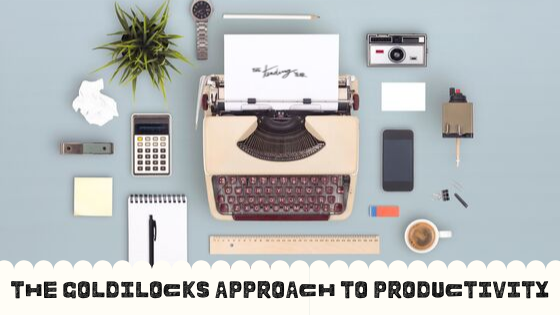Having recently studied flow—the magical space of feeling challenged and intrigued—I decided to approach my productivity with intention for finding a perfect window of pleasure, interest, and effectiveness.
I’m calling this method The Goldilocks Approach to Productivity.
Remember the childhood story where the little girl samples the three bears’ beds and foods? Something was always too much, not enough, and just right. I’m not the first one to apply to Goldilocks Principle to processes outside of children’s literature. It’s been assigned to fields ranging from psychology to astrobiology to medicine to economics, always with the aim of identifying a range that is “just right” for an ideal process to occur.
The Goldilocks Approach is a great fit for productivity—especially for projects that lack clear instructions or steps for completion or which lack a definition of what a good final product should look like. This reminds me of Brené Brown’s call for describing what “done” should look like to her team in her book Dare to Lead. When we can identify what “done” or “just right” looks like, we set ourselves up for success because we know what success looks like for an individual productivity session.
Here’s How It Works
Before you begin a session of productivity—be it writing, creating, grading, brainstorming, revising, coaching, etc.—take some time to identify what you’d like to accomplish by the end of your session. This is your just right goal, and you’ll determine it by first identifying what not enough and too much look like.
Here’s a sample from my use of the method to revise a draft of my dissertation chapter:

[Image description: a yellow post it on a light brown wooden desktop. The post it says “Goldilocks 9/27: too little – don’t finish reading; just right – today = read draft through once, outline &/or add to dos as fits; too much – write confusing/too many to dos, start new draft]
For me, not enough looked like not finishing reading my thirty page draft. Too much looked like writing confusing or too many to do instructions for myself, or starting a new draft entirely. Having identified the two poles, I was able to set an actionable and achievable goal: read through my draft once and outline and/or add to do instructions for myself as they fit. Note that I didn’t actually plan to write my revisions that day—instead I was focused on writing a list of things I wanted to revise the next time I sat down to work on my revision.
I used this just right goal as a motivator and as an accountability tool to keep me on track as I worked that day. Whenever I started to go off track or to feel anxious about when I would complete my final revisions, I looked to the Goldilocks plan I’d made. This boosted my focus, so I ended up finishing my day’s revision process swiftly. Once I completed my just right goal, I gave myself permission to put away my revision for the day and move on to other things.

To make your own Goldilocks Approach to Productivity, you should choose a project or a task that you’re working on and predetermine a set timeframe that you’ll dedicate to a productivity session. Knowing how much time you have to spend on a work session will help you to determine a realistic just right goal.
When you sit down to work, identify an actionable and achievable goal by writing down what would be not enough and too much for you to accomplish in that work session. Consider the time you have to work, your mood, your energy and focus levels, and the larger deadline for your project. Other things that might help you to determine what would be not enough or too much are how much scaffolding and preparation you’ve already done for this project. Don’t set yourself up to do unnecessary labor for this step of the project!
Be honest with yourself when it comes to determining what is not enough and too much. Think back to times when you failed to achieve your goals, and consider what obstacles caused you to miss your mark. Did you wait until the last minute to work on your project? Did you try to do too much at once, so you ended up feeling defeated and stressed? Allow that awareness to influence what too much and not enough would look like for your work session today.
If you’re still unsure of what to write for not enough and too much, scale your intention for your larger project down to this single work session and aim to accomplish enough to feel satisfied with your progress. You can do this by considering the total amount of work the larger project will demand and dividing it by how many more work sessions you will have before your final deadline.
Once you’ve determined what not enough and too much look like, identify your just right. I often ask my coaching clients (and myself) how a goal feels in their body. How does your just right feel when you check in with yourself? If you feel anxious or overwhelmed or hopeless, experiment with shifting the overwhelming goal to your too much category, and scale it down to create a new just right. Repeat this process until you feel engaged and comfortable—even eager!—about your goal, and then begin your session!
Newsletter
Sign up below to access my free newsletter, Tending with Dr. Kate Henry.

